Vehicle Safety Basics, How-To & Design Tips
Vehicle safety is the art of protecting the human occupant(s), at whatever cost to the vehicle. The vehicle is expendable, the occupants are not.
Human Physiology and Injuries
To protect the occupant(s) we first need to consider the basic physiological weak points of the human body:
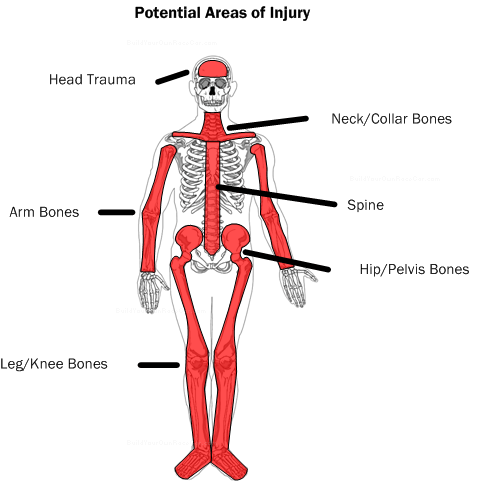
Diagram S1. Potential areas of injury. The design of the vehicle and the nature of the driving/racing environment largely determine the risk for different types of injuries.
As diagram S1 above shows, any parts of the body exposed to the chassis of the car are at risk of injury.
Injuries can take many forms–The most critical occur because the body receives impacts beyond the G (gravities) level that it can sustain. However, there are injuries to soft tissues that are received without these severe impacts.
The brain is particularly susceptible to injury, because it is a soft tissue mass stored inside a very solid bone container, the skull. The key to avoiding injury in the brain is to avoid instantaneous deceleration of the skull. When the skull strikes something hard, it decelerates instantaneously. The brain inside keeps moving which is what causes the head trauma.
Neck and spinal injuries also present a serious threat. These “Connector” type elements in our body are flexible and stretchable to a point and can sustain tremendous G loads before breaking. Like the brain, they will respond to impacts better if decelerated over a larger span of time. The spine and neck can also suffer from the effects of repeated jolting through the seat if not sufficiently supported and dampened.
Other bone injuries (breakages) are not as life-threatening, but still are to be prevented. The bones in our arms and legs perform well when stressed in tension and compression along their length. However, in the case of impacts they are often stressed in shear or bending.
Soft tissue bruising can also occur depending on the jolts and vibrations received by the body.
Driver/Occupant/Cockpit Safety
Driver and passenger (if any) safety systems consist of multiple layers of protection that are engineered to provide support and protection within and around the cockpit. Depending on the type of vehicle, these systems are composed of different elements but all of them have the same goal—to protect the occupants.
Let’s take a look at these elements, beginning at the outer-most layer and working our way to inner-most.
Impact Energy Absorption Structure
The first layer of protection for the occupants is the Impact Energy Absorption (IEA) structure. This is the destructible portion of the vehicle that absorbs impact energy from stationary objects (e.g. Walls) and other race or road vehicles. The energy is absorbed or dissipated by the crushing of the structure.
The greater the depth of the IEA structure, the longer it will take to crush it during an impact and therefore the longer the period of deceleration will be. Deceleration over a longer period of time, even if only milliseconds more, will result in lower G forces and in a lower chance of injury.
The internal design of the IEA structure is important as well. If possible, it should absorb energy consistently and predictably throughout its depth while being crushed.
The IEA structure for a unibody production-based car is shown in diagram IEA1 below in red. The entire body by nature of its monocoque/unibody design, provides a crushable structure. However, along the sides of the vehicle the structure is rather shallow and has limited crush strength, making impacts more dangerous from the side unless the structure is supplemented. In the case of a head-on or rear-end impact, the unibody IEA structure is deep and provides significant protection.
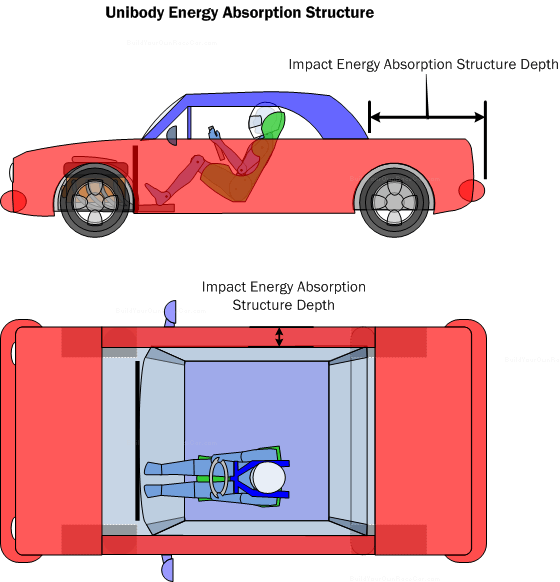
Diagram IEA1. Unibody vehicle impact energy absorption structure. Modern production-based vehicles are designed to absorb energy and protect occupants in a variety of crash situations. However side impact energy absorption is limited due to the requirements for interior passenger space and doors
The stockcar below in diagram IEA2 shows a tubular frame which makes the IEA structure an integral part of its occupant safety cell (See below for more information on Occupant Safety Cells). This dual-purpose frame enables the front and rear sections to be crushed while still protecting the occupant. Side impacts are absorbed more readily as well because the design of the safety cell includes the parallel tube side frame shown in the diagram. Unlike a fully reinforced spaceframe, this structure acts like a “bumper” and will crush to some extent, but still maintain protection for the driver.
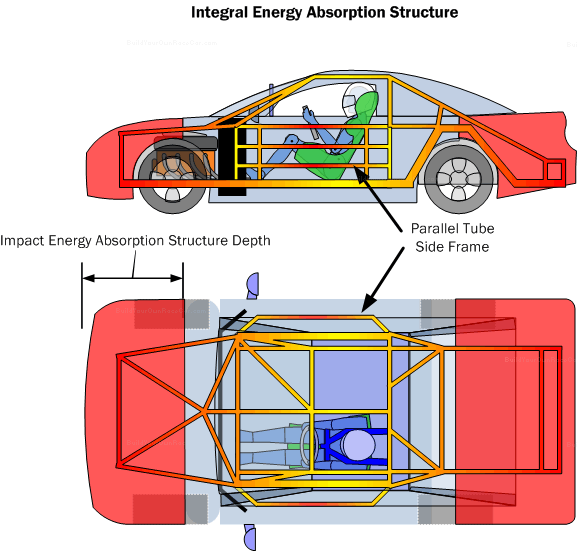
Diagram IEA2. The integral impact energy absorption structure integrates an outer crushable structure with an inner protective safety cell.
Due to the extensive use of tubular space frames in scratch-built amateur race and sports cars, IEA structures for these vehicles are often “Add-Ons”. The vehicle is both more cost-effective and potentially easier to construct/maintain if its chassis is composed of separate Occupant Safety cell/Cockpit (See Occupant Safety Cells below) and IEA structures. Diagram IEA3 below shows a formula car with “Add-on” IEA structures.
Add-on IEA structures do not interfere with nor complicate the design goals of the Occupant Safety cell or chassis. Also, if an IEA structure is damaged, it becomes a matter of replacing only the damaged IEA structure and inspecting/repairing the occupant safety cell.
The downside to Add-on structures is that they are only as good as the fasteners which attach them. Should the fastening system fail, the impact energy absorption structure will likely fail to perform its function and can become a danger itself.
The upside to Add-on structures is that they can be engineered to provide protection as desired. Add-On structures are generally made from composite materials. FRP (Fiberglass reinforced Plastic) over honeycomb or foam has been used extensively to provide uniformly crushable structures.
The formula car in the diagram below also shows that some components of a car can be IEA structures—The wishbones will absorb some energy upon collapsing.
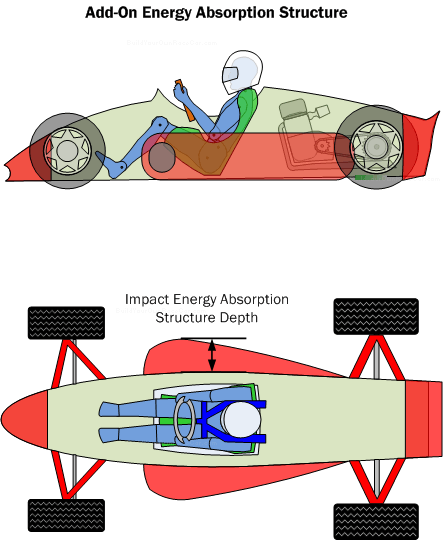
Diagram IEA3. Add-on impact energy absorption structures are separate from the occupant safety cell which enables them to be upgraded and replaced. However their design and fastening must ensure they do not become detached in the worst of crashes.
Firewall
Firewalls protect the occupants from fires within the chassis structure. They create separated areas for the engine and fuel storage so that the occupants are not harmed. They are generally composed of metal and fireproof insulated panels. In addition to direct fire, they provide protection from exhaust gas leaks or potential burn sources, and separate the Occupant Safety cell from high temperature components (engine/exhaust). Example firewalls are shown below in diagram FW1.
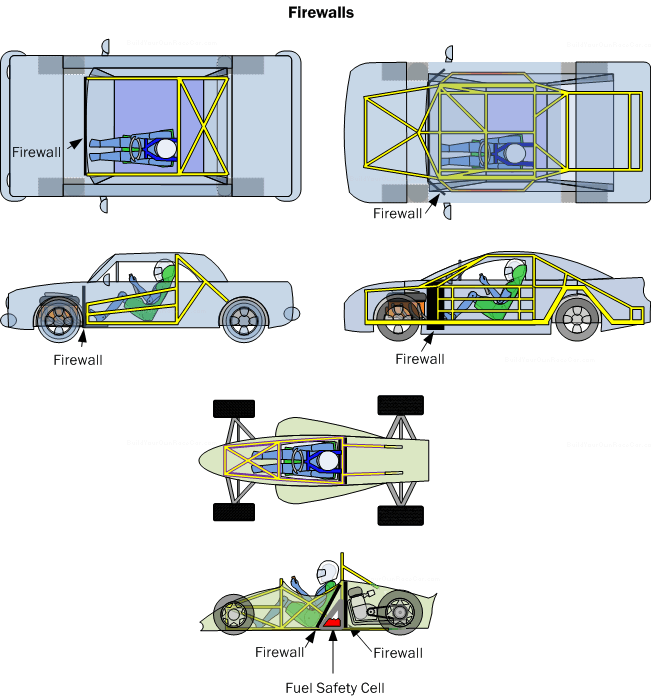
Diagram FW1. Firewalls in various types of vehicles. The goal is to seal off areas where fires could potential occur to ensure no flames or combustibles make it into the cockpit (including liquids).
Safety Tips (1/3)
Consider all types of safety when designing
When designing a vehicle you should always bear in mind the safety of each major component. How does it contribute to or detract from safety?
Use FRP skin over lightweight core material
For light weight IEA structures, use FRP bonded to a core material like honeycomb, balsa or high density Styrofoam. This is the same approach used by Formula One, and it results in very efficient energy absorption.
23 2 2

